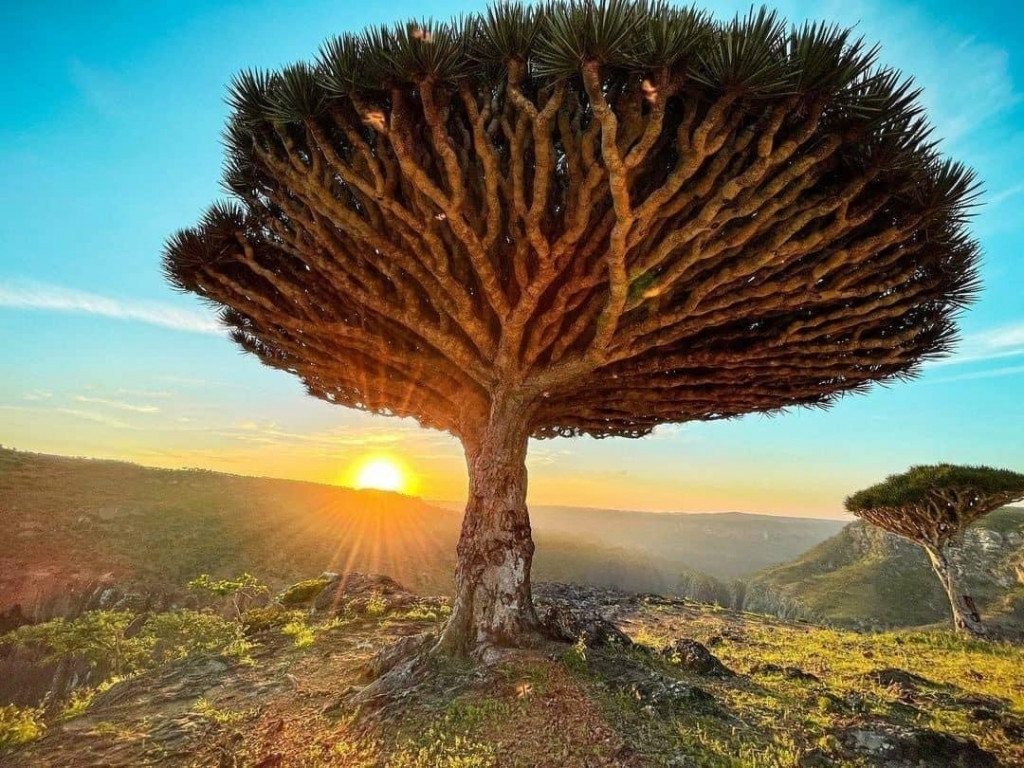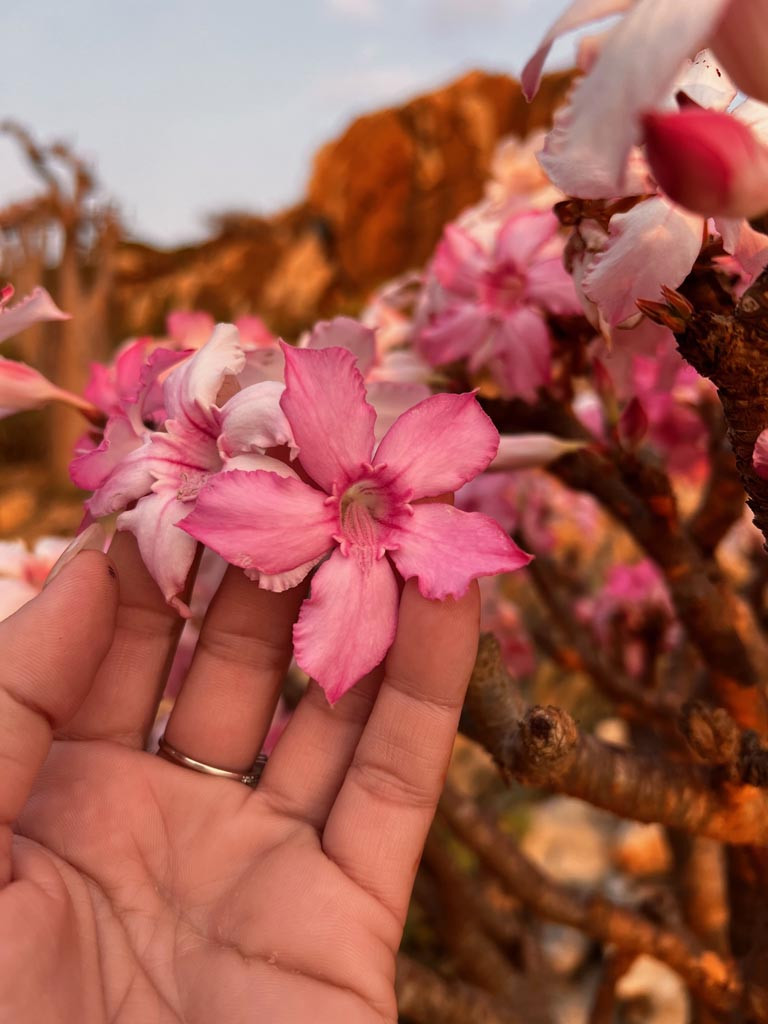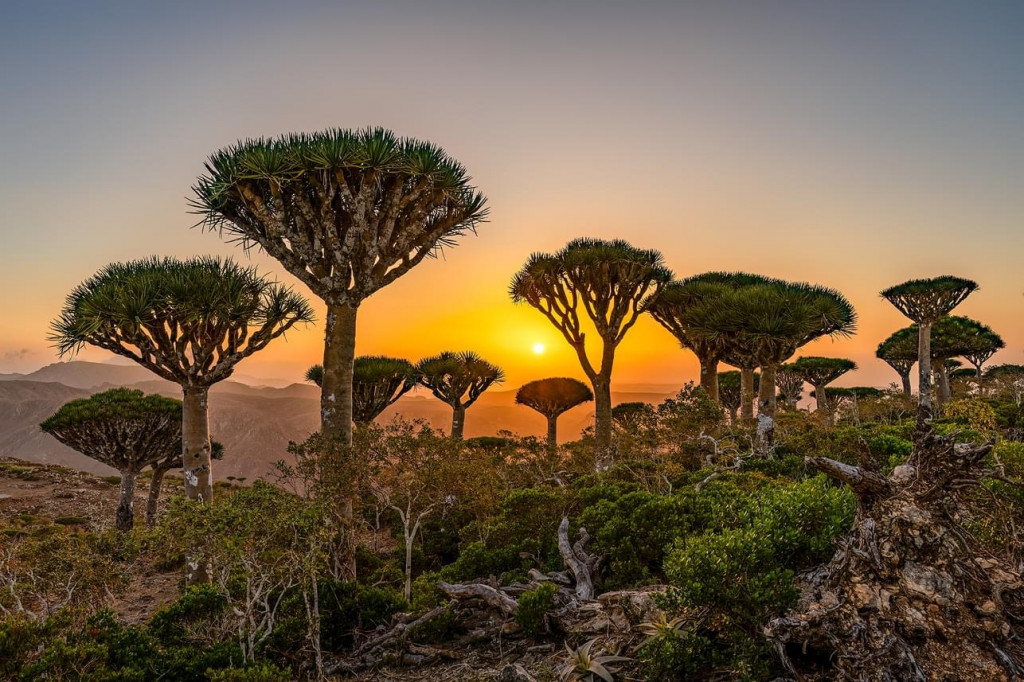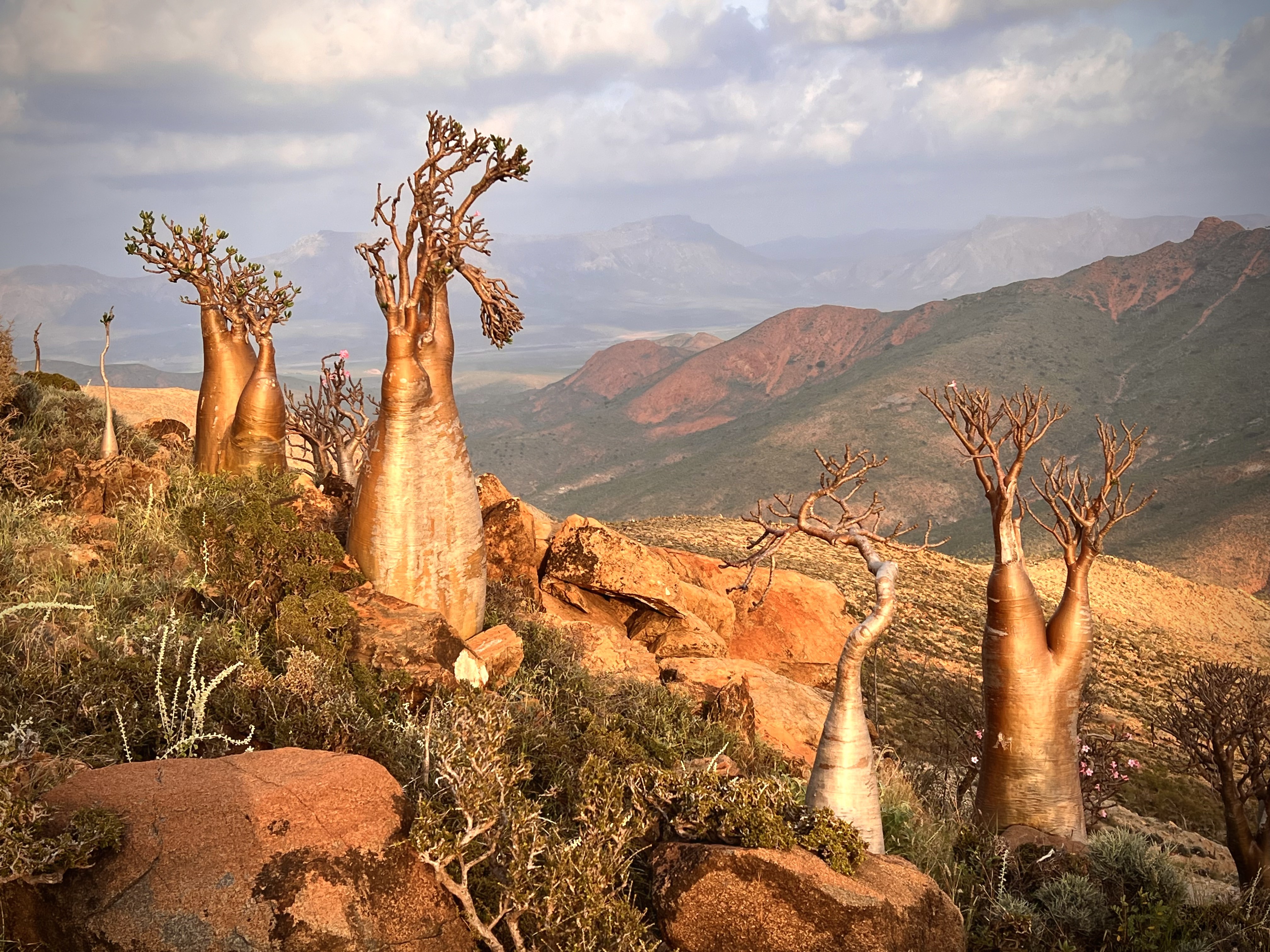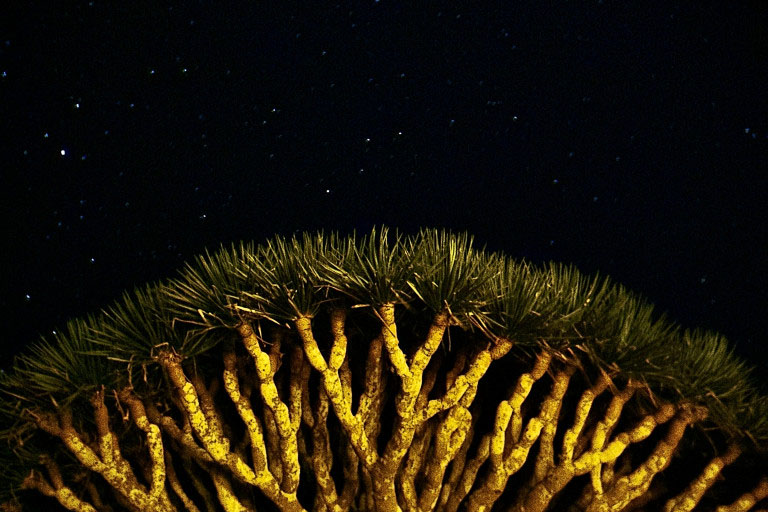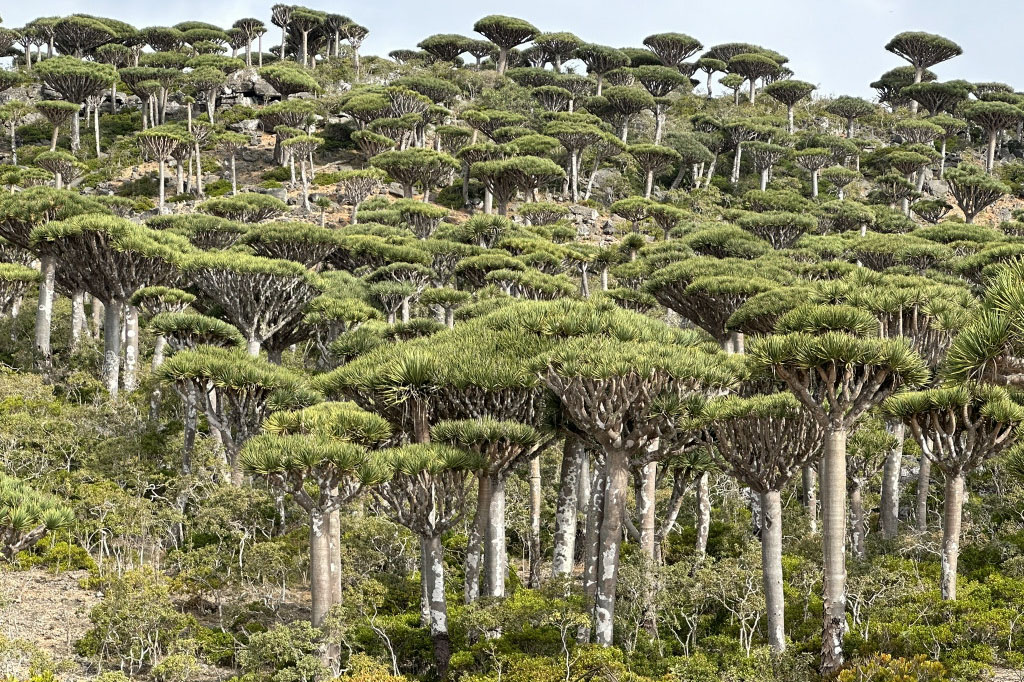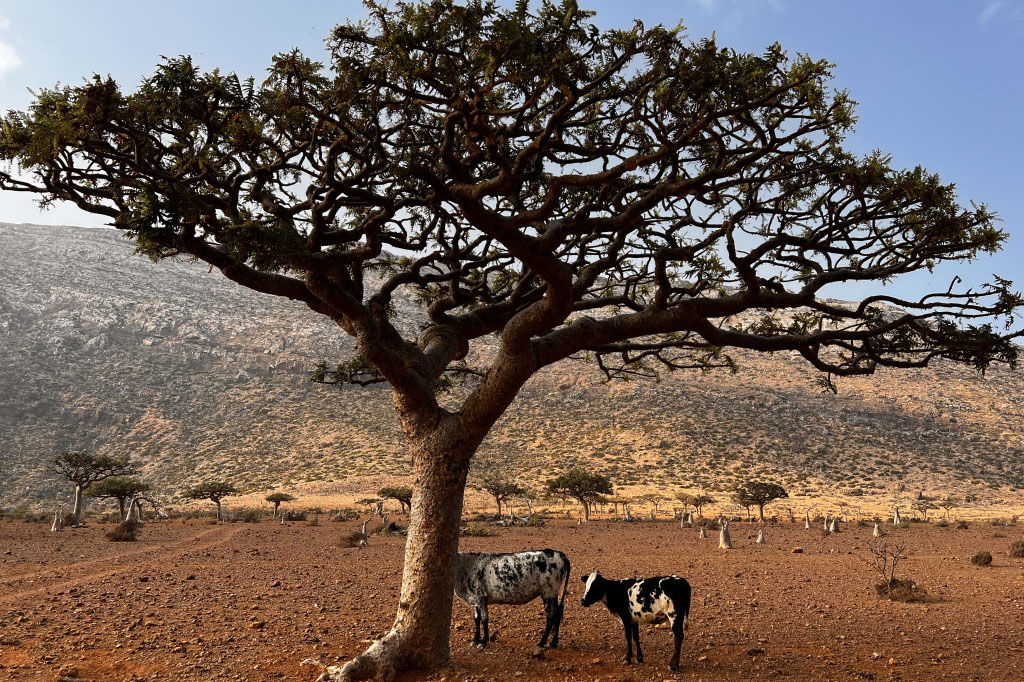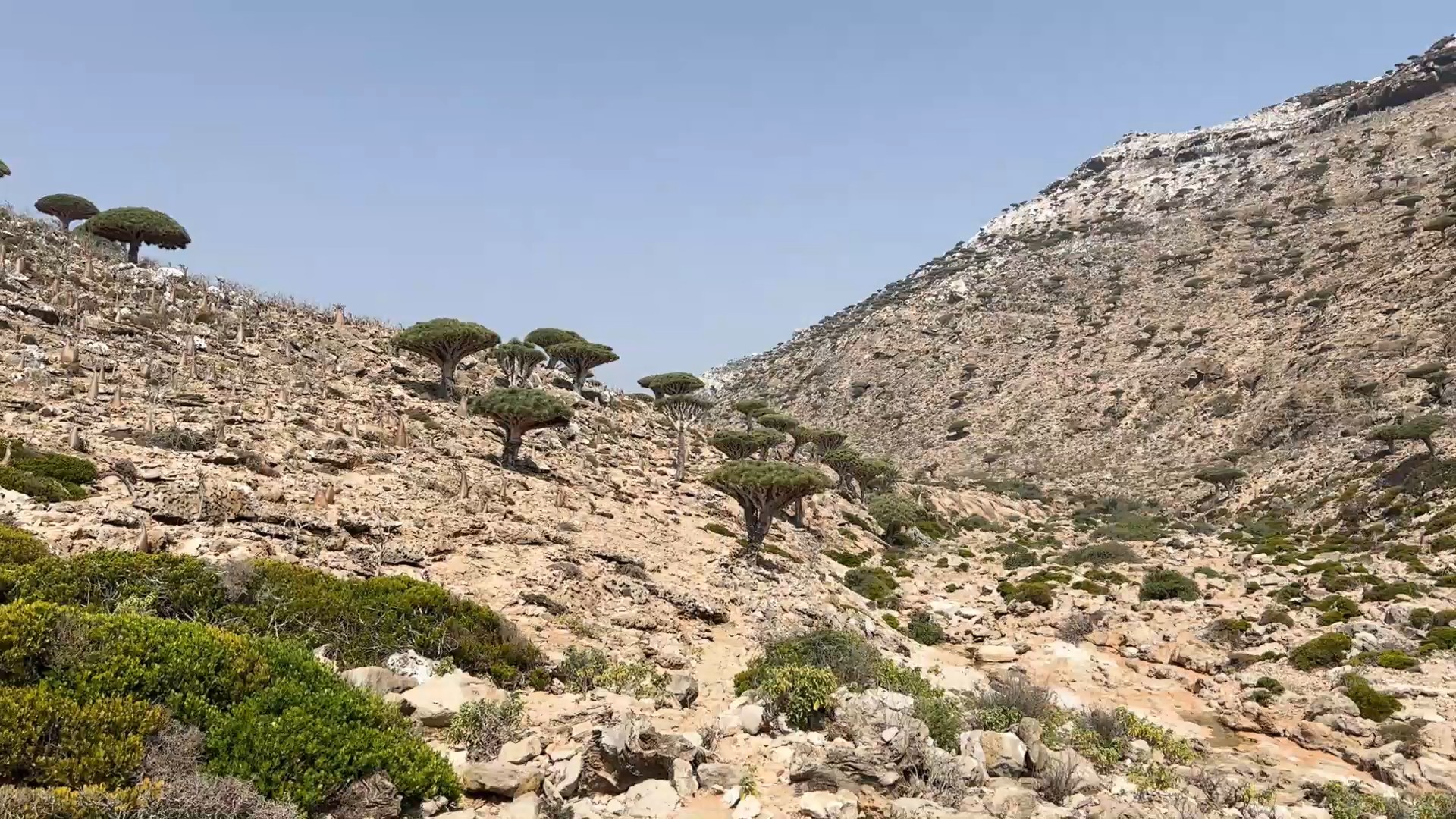

Endemic Flora
Flora of Socotra Island
The island’s entire living nature is unique, largely due to Socotra’s long-term isolation from the mainland.
From a botanical perspective, the Socotra archipelago is the tenth richest in the world in terms of endemic species.
There are 825 plant species described so far on Socotra, of which 37% are endemic.
Dragon Blood Tree (*Dracaena cinnabari*)
Also known as the dragon’s blood tree, these unique and beautiful trees form one of the planet’s oldest ecosystems, dating back to the Mesozoic era. Locals call them *dam al-ikhwan* (blood of the two brothers). The name comes from the red sap the tree produces. It has a distinctive appearance with a dense umbrella-shaped crown resembling a giant mushroom and grows up to 6 to 9 meters in height. This unusual crown shape is an adaptation to arid conditions.
These trees can live for several centuries. As monocotyledonous plants, their exact age cannot be determined, but estimates suggest 300–500 years. Around 9,000 dragon blood trees still grow on Socotra—about 40% of all specimens on Earth. They’ve seen a lot—these trees were already present when dinosaurs roamed the Earth. The red resin (cinnabar), or “dragon’s blood,” was used as an anti-inflammatory, antiseptic, paint pigment, and even for dyeing violin varnish. Unfortunately, the trees are not regenerating naturally. Young saplings are rare due to overgrazing by goats. Desertification and population growth are increasing pressure on pastures, preventing the trees from reproducing.
Frankincense Tree (*Boswellia sacra*)
This rare tree grows to 2–8 meters and produces valuable aromatic resin—frankincense. It is harvested by cutting the bark, trunk, or branches. The initially milky sap dries into pale yellow, brownish, or transparent granules that emit a strong fragrance when heated. Steam distillation of the resin yields essential oil, used primarily in aromatherapy. Historically regarded as a cure-all, frankincense was used for its antiseptic properties in prehistoric medicine. Trade in frankincense became a very profitable business; it was so precious it rivaled gold in value. Ancient Egyptians used it in the embalming process.
Bottle Tree (*Adenium obesum socotranum*)
An endemic succulent with no established English common name, often called “desert rose” or colloquially “the bottle.” Its thick trunk resembles a baobab or, some say, an old woman’s backside. It bears stunning red-and-white flowers on a swollen stem and grows up to 3 meters tall. The trunk serves as a large water reservoir. During dry seasons, it sheds its leaves, leaving only blossoms on bare branches.
Myrrh Tree (*Commiphora ornifolia*)
A sturdy tree with twisted branches and grayish bark that peels off in large patches. It can grow up to 8 meters tall. Its leaves are bright green, and it produces inconspicuous clustered flowers. It is widespread on Socotra, especially in dense scrublands and semi-deciduous forests between 0–800 meters above sea level.
(*Commiphora planifrons*)
A smaller tree with a sparse crown of horizontal, gnarled, sometimes thorny branches and peeling bark. Its unusual leaves appear to be composed of small, spherical, slightly concave segments arranged in two rows. They have a velvety texture and a greenish-brown color.
When the bark is cut, myrrh trees produce aromatic resin droplets in yellow or reddish-brown, which harden and darken when exposed to air. Alongside frankincense, myrrh was a highly prized commodity, especially by Egyptians and Romans who used it in embalming. Like frankincense, oil can be extracted from myrrh for perfumes and cosmetics.
Other Endemic Plant Species
Cucumber Tree (*Dendrosicyos socotrana*)
Recognizable by its thick white bark and bottle- or cone-shaped trunk that can reach 1 meter in diameter. It is the only known woody member of the gourd family. It has a small crown of heart-shaped leaves covered in short spines. It grows to 4–6 meters and is found in lowland areas along the coast and wadis near the Hagghier mountain range.
Bindweed (*Convolvulus filipes*)
A perennial creeping or sprawling herb with hairy stems and white to pale pink flowers. It grows on rocky slopes, plains, and shallow soils from sea level to about 650 meters.
Jute Plant (*Corchorus erodioides*)
An annual or short-lived herb that grows up to 15 cm. Its oval to elongated leaves form a basal rosette from which bright yellow flowers emerge on stalks 5–12 cm long. It grows near streams and moist clay or loamy soils up to 800 meters altitude.
Thulin (*Crotalaria socotrana*)
A large shrub or small deciduous tree with upright branches. Its elongated leaves and yellow flowers cluster at the ends of branches.
Grass (*Dichanthium spicatum*)
A perennial grass forming dense tufts up to 1 meter tall, commonly found in grassy areas and on rocky slopes at lower elevations.
Velutina (*Eugenia velutina*)
A small tree or shrub with dark green glossy leaves and white flowers, typically found in moist and shaded areas.
Andelin (*Indigofera socotrana*)
A shrub with clusters of purple flowers, found on rocky slopes and in scrublands.
Gundelin (*Lagenaria socotrana*)
A climbing plant with gourd-like fruits, found in lowland regions.
Oncosiphon (*Oncosiphon socotranus*)
An herb with fine leaves and yellow flowers, growing in dry, rocky areas.
Patalka (*Pulicaria gossweileri*)
An herb with yellow flowers, found in grassy fields.
Starwort (*Stenocline sokotrana*)
A small shrub with white flowers, growing in mountainous areas.
Goldenbush (*Tephrosia socotrana*)
A shrub with yellow flowers, found in dry habitats.


